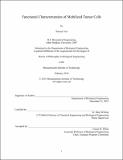| dc.contributor.advisor | K. Dane Wittrup. | en_US |
| dc.contributor.author | Yao, Xiaosai | en_US |
| dc.contributor.other | Massachusetts Institute of Technology. Department of Biological Engineering. | en_US |
| dc.date.accessioned | 2014-10-08T15:22:17Z | |
| dc.date.available | 2014-10-08T15:22:17Z | |
| dc.date.copyright | 2014 | en_US |
| dc.date.issued | 2014 | en_US |
| dc.identifier.uri | http://hdl.handle.net/1721.1/90679 | |
| dc.description | Thesis: Ph. D., Massachusetts Institute of Technology, Department of Biological Engineering, 2014. | en_US |
| dc.description | Cataloged from PDF version of thesis. | en_US |
| dc.description | Includes bibliographical references (pages 101-106). | en_US |
| dc.description.abstract | Despite being responsible for 90% of cancer mortality, metastasis is not well understood. This thesis is focused on the circulation step of the metastatic cascade, examining three types of mobilized tumor cells: circulating tumor cells (CTCs), intraoperatively shed tumor cells, and malignant pleural effusions (MPE). We investigated the functional behavior of mobilized tumor cells in order to explain the discrepancy between the number of tumor cells in circulation and the number overt metastases. The first part of this thesis examines the functional behavior of CTCs isolated from the peripheral blood of metastatic castration-resistant prostate cancer patients. Individual CTCs were compartmentalized using arrays of nanowells to enable clonal comparison and mapping of heterogeneity. The viability, invasiveness and secretory profiles of CTCs were measured. Only a subset of CTCs was found to possess malignant traits indicative of metastatic potential. These CTCs were resistant to anoikis, were invasive or secreted proteolytic enzymes. The second part of this thesis determines the presence of intraoperatively shed tumor cells using blood samples withdrawn from the pulmonary vein after pulmonary lobectomy procedures. Previous studies did not distinguish tumor cells from normal epithelial cells specifically or sensitively. Single-cell genetic approaches were used to compare the genotype of isolated single cells to matched tumor cells and normal adjacent tissue, thereby confirming the malignancy of shed epithelial cells. The third and last part of the thesis delineates the tumorigenic population with surface markers using MPEs. A total of 35 surface antigens were screened from four categories: 1) cancer stem cell 2) epithelial-mesenchymal transition 3) metastatic signature and 4) tyrosine kinase receptors. Surface antigen CD24 was found to be specifically and abundantly expressed in MPE, and was required for the colonization of the lung. In conclusion, metastatic inefficiency is due to the presence of inactive cells and cellular heterogeneity. Inactive cells are either normal epithelial cells or apoptotic tumor cells. Cellular heterogeneity may arise from differences in surface marker expression or functional states. Therefore, only a subset of mobilized tumor cells can give rise to metastases, and therapeutic strategies should be focused on this subset. | en_US |
| dc.description.statementofresponsibility | by Xiaosai Yao. | en_US |
| dc.format.extent | 106 pages | en_US |
| dc.language.iso | eng | en_US |
| dc.publisher | Massachusetts Institute of Technology | en_US |
| dc.rights | MIT theses are protected by copyright. They may be viewed, downloaded, or printed from this source but further reproduction or distribution in any format is prohibited without written permission. | en_US |
| dc.rights.uri | http://dspace.mit.edu/handle/1721.1/7582 | en_US |
| dc.subject | Biological Engineering. | en_US |
| dc.title | Functional characterization of mobilized tumor cells | en_US |
| dc.type | Thesis | en_US |
| dc.description.degree | Ph. D. | en_US |
| dc.contributor.department | Massachusetts Institute of Technology. Department of Biological Engineering | |
| dc.identifier.oclc | 890466638 | en_US |
